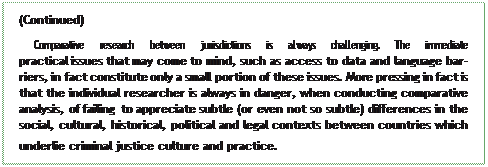 |
Comparative work in crime and criminology
|
|
|
|
COMPARATIVE WORK IN CRIME AND CRIMINOLOGY
The preceding discussion of globalization might at first be taken to imply that comparative work has in fact become less worthwhile than might previously have been the case. After all, in a world increasingly interconnected and sharing com- mon solutions and models to all manner of criminal justice problems, it may now make less sense to demarcate strictly between ‘British’ (say) and other criminal justice systems. As Roux (2002: 430) argues: ‘In this day and age, no country can view itself as an island. All countries, great and small, developed or developing, experience the effects of globalisation. ’ Neverthless, the danger in this is that it remains a vast oversimplification to approach the globalization of crime and crim- inal justice simply as being tantamount to ‘all’ jurisdictions producing identical solutions to given problems. On this point, Nelken (1997) and Muncie (2005) have emphasized that whilst ‘blueprint’ solutions to the problems presented by crime and disorder are now commonly proliferated internationally, ‘the argument that criminal justice is becoming a standardised global product can only be sustained at the very highest level of generality’ (Nelken, 1997: 252). As a consequence, such blueprints become adapted to the more local context. Comparative work therefore has a significant role to play in explaining how any given model of criminal justice that works in one social, political or legal context, may work differently in another context and within a different jurisdiction. In an age of evidence-based criminal justice policy, comparative work in fact comes to the fore to help ensure policy makers do not simply employ ‘off the shelf ’ solutions which are unsuitable to their own particular situation. Thus, Box 20. 1 provides an example of the practical dif- ficulties in finding common solutions to the relatively well-researched issue of ‘burglary’ across four European countries.

BOX 20. 1 UNDERSTANDING ‘BURGLARY’ACROSS JURISDICTIONS
Mawby (1998) set out to compare the experiences of burglary victims with police services in England, Germany, Poland and Hungary. An initial problem described by the author was that the notion of ‘burglary’ differed to greater and lesser extents across all these jurisdictions, such that, in England, the definition of burglary of a dwelling included the following:
1. Breaking into a home through door or window.
2. Using other methods (e. g. credit cards) to enter through a locked door or window without causing damage.
3. Entering through an open window.
4. Entering through an open door.
5. Entering without permission, where the offender uses trickery to gain access.
In contrast, in Germany, only the first three examples would be defined by law and statistical classification as burglary (‘Einbruch’). Indeed, Mawby notes here that while entry through an open window is officially categorized in this way by German law- yers, the crime is commonly referred to as ‘einstiegen’ (‘to break into’) rather than burglary. Moreover, examples (iv) and (v) given above are generally defined as simple theft. In Hungary and Poland, Mawby notes that definitions of burglary were rather more like those in Germany than those in England, although they too differed from these in some respects.
|
|
|
One key writer on comparative criminology, David Nelken, notes on this point that:
An important issue for policy in many societies involves deciding when and how to borrow foreign ideas and practices in criminal justice, which ones are likely to be most appropriate and in what sense punishment practices are ‘embedded’ in a given context. (Nelken, 2007: 142)
Comparative research is therefore considered to bring a number of distinct advan- tages, not least of which, first, is its ability to provide an in-depth understanding of how justice systems throughout the world operate. Second, understanding how justice systems evolve and are challenged gives policy makers the basis for helping developing nations advance their justice systems to better cope with internal and transnational crime problems. Third, by conducting comparative research concern- ing factors related to policy and its implementation, researchers and practitioners can foresee problems and guide the policy to successful implementation. Finally, by studying justice systems worldwide, researchers can begin to collect an inventory of ‘best practices’ in criminal justice (Bennett, 2009).
(Continued)

Comparing criminal justice responses between jurisdictions is therefore a complex task, as Box 20. 1 details, and care must be taken on the part of both the researcher and indeed the audience of that research to avoid making unfair or sweeping gener- alizations. Of course, methodologically this is a problem inherent to all transnational or international comparisons and such disadvantages must be viewed in light of the real benefits accrued from comparative research, particularly where it bridges con- ventional classifications (for example, between common law and civil law countries). If carried out with due care, comparative work can allow ‘difference’ (in policies, in justifications and in practices) to act as a lens for the understanding of policy and practice development.
Nelken (2007), for his part, offers three possible approaches by which sufficient knowledge from other jurisdictions might be gained in order to overcome some of the difficulties discussed above with comparative work. He characterizes these as involving the researcher being ‘virtually there’ (i. e. in the foreign jurisdiction being studied), ‘researching there’ and ‘living there’. Each of these approaches does how- ever bring with it its own advantages and disadvantages, as set out in Box 20. 2.
 | |||
 | |||
 arrangements for misinterpretation and lack of understanding because, funda- mentally, the researcher may remain less sensitive to ‘broader institutional and ideological contexts’ (p. 97).
arrangements for misinterpretation and lack of understanding because, funda- mentally, the researcher may remain less sensitive to ‘broader institutional and ideological contexts’ (p. 97).
2. Researching there: To address the drawbacks of the first approach, Nelken’s second method encompasses short research visits to the countries in question to learn ‘on the ground’ through fieldwork, interviews and other methods. The key advantages are that ‘immersion in another ostial context gives the researcher invaluable opportunities to become more directly involved in the experience of cultural translation’ (p. 145). The process also allows for more open-ended inquiry and the discovery of new questions. The disadvantages of this approach, how- ever, revolve around over-reliance on particular actors visited or interviewed in a relatively short time frame as ‘representative’ of a country in question. It therefore raises the important question (as does the previous method) of who counts as an ‘expert’ on said country. This is especially the case given that, by definition, such ‘experts’ will be part of the very culture they are describing.
|
|
|
3. Living there: Nelken’s ‘living there’ conceptualization takes the next step of researchers spending considerable time in a foreign jurisdiction, such that they begin to break down the cultural assumptions they bring with them and become aware of, and indeed part of, the taken-for-granted social context experienced by natives. In some ways, however, this is the most difficult method to actually real- ize given the time, practical and monetary limitations. Indeed, funding for com- parative studies is the major roadblock to their undertaking. Any study that involves more than one nation will be costly, whether it employs original archival data, observations, interviews, or the administration of surveys (Bennett, 2009). Overall, Nelken warns that, in practice, pursuing this approach may sometimes reduce the quality of the research if it is pursued at the expense of a broader data set which could be gleaned from other methods.
Another typology for categorizing comparative crime and criminal justice studies is offered by Bennett (2009) who characterizes such studies by reference to four essen- tial features: approach, scope, data and design, as explained in Box 20. 3.
 |


Clearly, there is no ‘standard’ way of approaching internationally comparative work. Indeed, addressing the difficulties and challenges of this work will often require researchers to consider novel solutions to individual challenges arising in dif- ferent cases. In the next section, this chapter will examine in more detail how some comparative projects in the fields of crime, policing and victimization, have approached such challenges.
|
|
|


